2016 HYUNDAI GENESIS COUPE ULTIMATE fuel cap
[x] Cancel search: fuel capPage 381 of 475
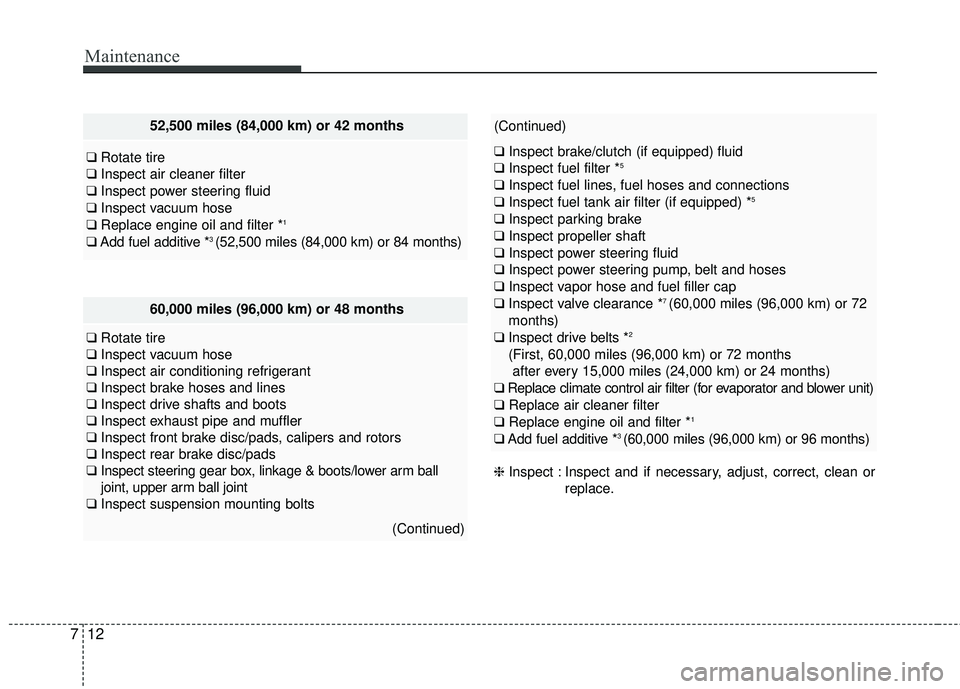
Maintenance
12
7
60,000 miles (96,000 km) or 48 months
❑ Rotate tire
❑ Inspect vacuum hose
❑ Inspect air conditioning refrigerant
❑ Inspect brake hoses and lines
❑ Inspect drive shafts and boots
❑ Inspect exhaust pipe and muffler
❑ Inspect front brake disc/pads, calipers and rotors
❑ Inspect rear brake disc/pads
❑ Inspect steering gear box, linkage & boots/lower arm ball
joint, upper arm ball joint
❑ Inspect suspension mounting bolts
(Continued)
(Continued)
❑Inspect brake/clutch (if equipped) fluid
❑ Inspect fuel filter *5
❑Inspect fuel lines, fuel hoses and connections
❑ Inspect fuel tank air filter (if equipped) *5
❑Inspect parking brake
❑ Inspect propeller shaft
❑ Inspect power steering fluid
❑ Inspect power steering pump, belt and hoses
❑ Inspect vapor hose and fuel filler cap
❑ Inspect valve clearance *
7 (60,000 miles (96,000 km) or 72
months)
❑ Inspect drive belts *
2
(First, 60,000 miles (96,000 km) or 72 months
after every 15,000 miles (24,000 km) or 24 months)
❑ Replace climate control air filter (for evaporator and blower unit)
❑ Replace air cleaner filter
❑ Replace engine oil and filter *
1
❑Add fuel additive *3 (60,000 miles (96,000 km) or 96 months)
52,500 miles (84,000 km) or 42 months
❑ Rotate tire
❑ Inspect air cleaner filter
❑ Inspect power steering fluid
❑ Inspect vacuum hose
❑ Replace engine oil and filter *
1
❑Add fuel additive *3 (52,500 miles (84,000 km) or 84 months)
❈ Inspect : Inspect and if necessary, adjust, correct, clean or
replace.
Page 383 of 475
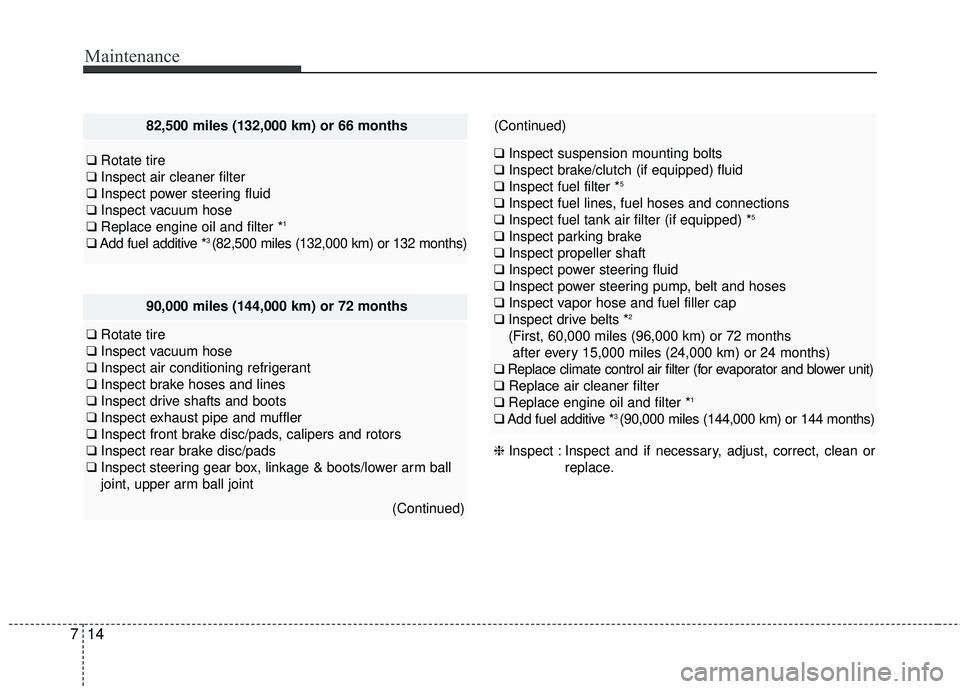
Maintenance
14
7
90,000 miles (144,000 km) or 72 months
❑ Rotate tire
❑ Inspect vacuum hose
❑ Inspect air conditioning refrigerant
❑ Inspect brake hoses and lines
❑ Inspect drive shafts and boots
❑ Inspect exhaust pipe and muffler
❑ Inspect front brake disc/pads, calipers and rotors
❑ Inspect rear brake disc/pads
❑ Inspect steering gear box, linkage & boots/lower arm ball
joint, upper arm ball joint
(Continued)
(Continued)
❑ Inspect suspension mounting bolts
❑ Inspect brake/clutch (if equipped) fluid
❑ Inspect fuel filter *
5
❑Inspect fuel lines, fuel hoses and connections
❑ Inspect fuel tank air filter (if equipped) *5
❑Inspect parking brake
❑ Inspect propeller shaft
❑ Inspect power steering fluid
❑ Inspect power steering pump, belt and hoses
❑ Inspect vapor hose and fuel filler cap
❑ Inspect drive belts *
2
(First, 60,000 miles (96,000 km) or 72 months
after every 15,000 miles (24,000 km) or 24 months)
❑ Replace climate control air filter (for evaporator and blower unit)
❑ Replace air cleaner filter
❑ Replace engine oil and filter *
1
❑Add fuel additive *3 (90,000 miles (144,000 km) or 144 months)
82,500 miles (132,000 km) or 66 months
❑ Rotate tire
❑ Inspect air cleaner filter
❑ Inspect power steering fluid
❑ Inspect vacuum hose
❑ Replace engine oil and filter *
1
❑Add fuel additive *3 (82,500 miles (132,000 km) or 132 months)
❈ Inspect : Inspect and if necessary, adjust, correct, clean or
replace.
Page 385 of 475
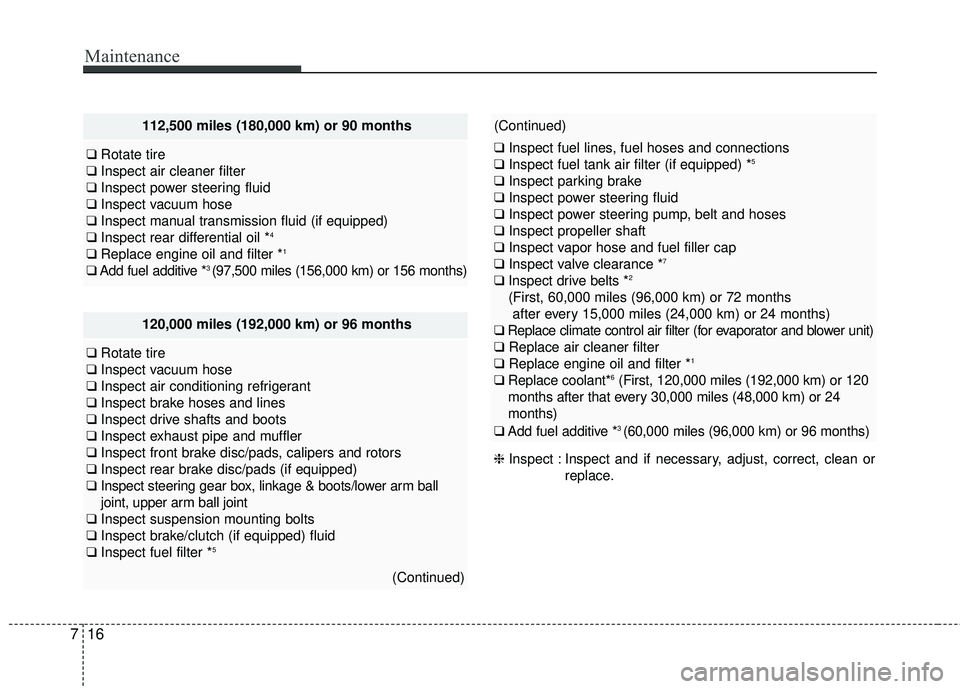
Maintenance
16
7
120,000 miles (192,000 km) or 96 months
❑ Rotate tire
❑ Inspect vacuum hose
❑ Inspect air conditioning refrigerant
❑ Inspect brake hoses and lines
❑ Inspect drive shafts and boots
❑ Inspect exhaust pipe and muffler
❑ Inspect front brake disc/pads, calipers and rotors
❑ Inspect rear brake disc/pads (if equipped)
❑ Inspect steering gear box, linkage & boots/lower arm ball
joint, upper arm ball joint
❑ Inspect suspension mounting bolts
❑ Inspect brake/clutch (if equipped) fluid
❑ Inspect fuel filter *
5
(Continued)
112,500 miles (180,000 km) or 90 months
❑Rotate tire
❑ Inspect air cleaner filter
❑ Inspect power steering fluid
❑ Inspect vacuum hose
❑ Inspect manual transmission fluid (if equipped)
❑ Inspect rear differential oil *
4
❑Replace engine oil and filter *1
❑Add fuel additive *3 (97,500 miles (156,000 km) or 156 months)
❈ Inspect : Inspect and if necessary, adjust, correct, clean or
replace.
(Continued)
❑Inspect fuel lines, fuel hoses and connections
❑ Inspect fuel tank air filter (if equipped) *5
❑Inspect parking brake
❑ Inspect power steering fluid
❑ Inspect power steering pump, belt and hoses
❑ Inspect propeller shaft
❑ Inspect vapor hose and fuel filler cap
❑ Inspect valve clearance *
7
❑Inspect drive belts *2
(First, 60,000 miles (96,000 km) or 72 months
after every 15,000 miles (24,000 km) or 24 months)
❑ Replace climate control air filter (for evaporator and blower unit)
❑ Replace air cleaner filter
❑ Replace engine oil and filter *
1
❑Replace coolant*6(First, 120,000 miles (192,000 km) or 120
months after that every 30,000 miles (48,000 km) or 24
months)
❑ Add fuel additive *
3 (60,000 miles (96,000 km) or 96 months)
Page 387 of 475
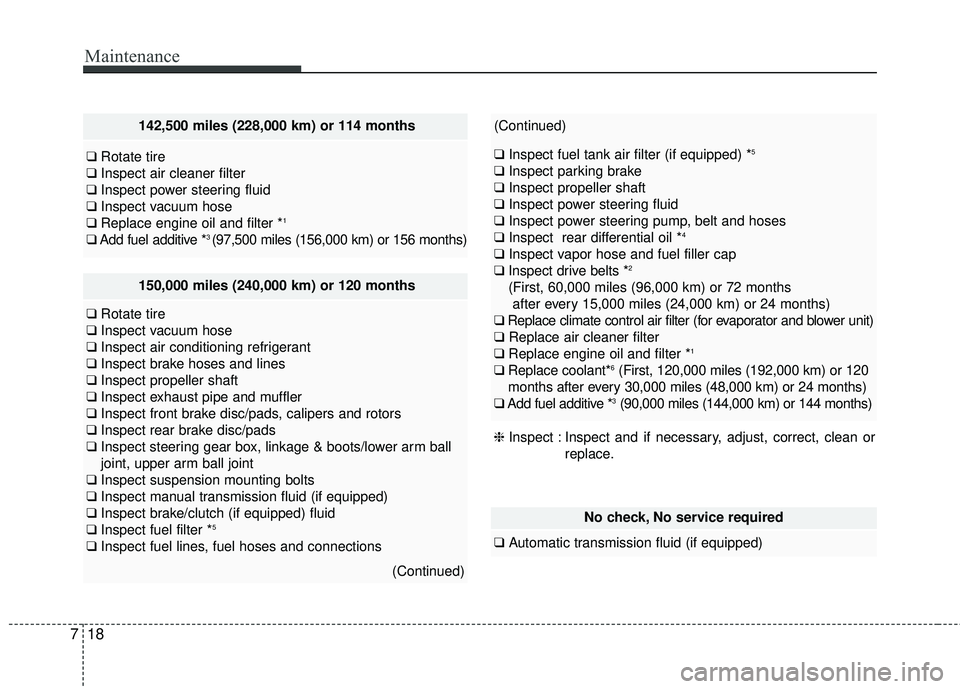
Maintenance
18
7
142,500 miles (228,000 km) or 114 months
❑ Rotate tire
❑ Inspect air cleaner filter
❑ Inspect power steering fluid
❑ Inspect vacuum hose
❑ Replace engine oil and filter *
1
❑Add fuel additive *3 (97,500 miles (156,000 km) or 156 months)
(Continued)
❑ Inspect fuel tank air filter (if equipped) *5
❑Inspect parking brake
❑ Inspect propeller shaft
❑ Inspect power steering fluid
❑ Inspect power steering pump, belt and hoses
❑ Inspect rear differential oil *
4
❑Inspect vapor hose and fuel filler cap
❑ Inspect drive belts *2
(First, 60,000 miles (96,000 km) or 72 months
after every 15,000 miles (24,000 km) or 24 months)
❑ Replace climate control air filter (for evaporator and blower unit)
❑ Replace air cleaner filter
❑ Replace engine oil and filter *
1
❑Replace coolant*6(First, 120,000 miles (192,000 km) or 120
months after every 30,000 miles (48,000 km) or 24 months)
❑ Add fuel additive *
3 (90,000 miles (144,000 km) or 144 months)
150,000 miles (240,000 km) or 120 months
❑ Rotate tire
❑ Inspect vacuum hose
❑ Inspect air conditioning refrigerant
❑ Inspect brake hoses and lines
❑ Inspect propeller shaft
❑ Inspect exhaust pipe and muffler
❑ Inspect front brake disc/pads, calipers and rotors
❑ Inspect rear brake disc/pads
❑ Inspect steering gear box, linkage & boots/lower arm ball
joint, upper arm ball joint
❑ Inspect suspension mounting bolts
❑ Inspect manual transmission fluid (if equipped)
❑ Inspect brake/clutch (if equipped) fluid
❑ Inspect fuel filter *
5
❑Inspect fuel lines, fuel hoses and connections
(Continued)
No check, No service required
❑Automatic transmission fluid (if equipped)
❈ Inspect : Inspect and if necessary, adjust, correct, clean or
replace.
Page 389 of 475

Maintenance
20
7
EXPLANATION OF SCHEDULED MAINTENANCE ITEMS
Engine oil and filter
The engine oil and filter should be
changed at the intervals specified in
the maintenance schedule. If the car
is being driven in severe conditions,
more frequent oil and filter changes
are required.
Drive belts
Inspect all drive belts for evidence of
cuts, cracks, excessive wear or oil
saturation and replace if necessary.
Fuel filter
A clogged filter can limit the speed at
which the vehicle may be driven,
damage the emission system and
cause multiple issues such as hard
starting. If an excessive amount of
foreign matter accumulates in the
fuel tank, the filter may require
replacement more frequently.
After installing a new filter, run the
engine for several minutes, and
check for leaks at the connections.
Fuel filters should be installed by an
authorized HYUNDAI dealer.
Fuel lines, fuel hoses and con-
nections
Check the fuel lines, fuel hoses and
connections for leakage and dam-
age. Have an authorized HYUNDAI
dealer replace any damaged or leak-
ing parts immediately.
Vapor hose and fuel filler cap
The vapor hose and fuel filler cap
should be inspected at those inter-
vals specified in the maintenance
schedule. Make sure that a new
vapor hose or fuel filler cap is cor-
rectly replaced.
Vacuum crankcase ventilation
hoses (if equipped)
Inspect the surface of hoses for evi-
dence of heat and/or mechanical
damage. Hard and brittle rubber,
cracking, tears, cuts, abrasions, and
excessive swelling indicate deterio-
ration. Particular attention should be
paid to examine those hose surfaces
nearest to high heat sources, such
as the exhaust manifold.
Inspect the hose routing to assure
that the hoses do not come in con-
tact with any heat source, sharp
edges or moving component which
might cause heat damage or
mechanical wear. Inspect all hose
connections, such as clamps and
couplings, to make sure they are
secure, and that no leaks are pres-
ent. Hoses should be replaced
immediately if there is any evidence
of deterioration or damage.
Page 420 of 475
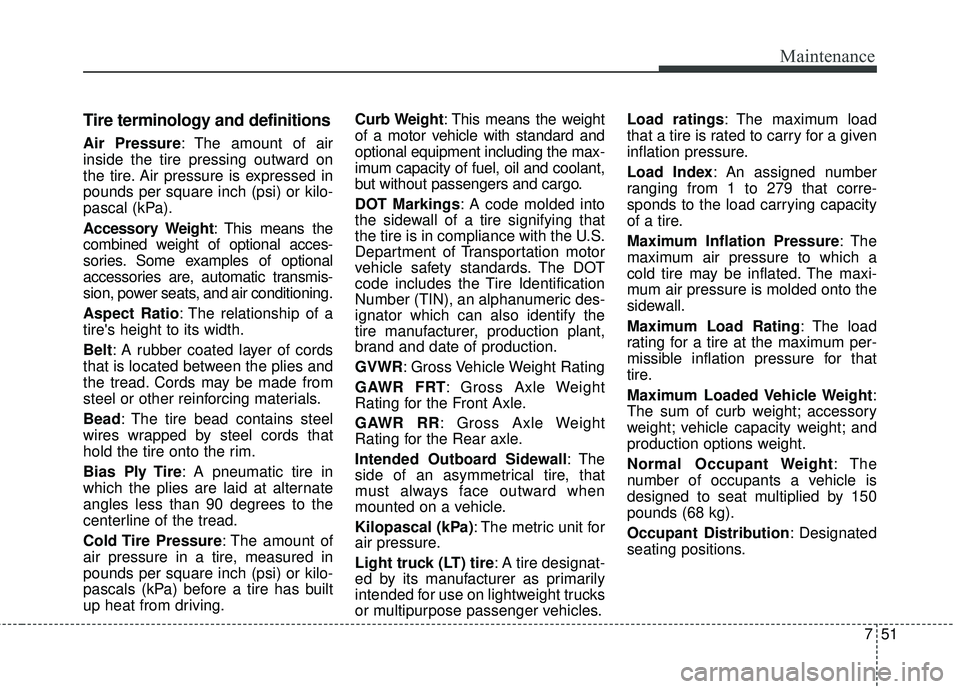
751
Maintenance
Tire terminology and definitions
Air Pressure: The amount of air
inside the tire pressing outward on
the tire. Air pressure is expressed in
pounds per square inch (psi) or kilo-
pascal (kPa).
Accessory Weight: This means the
combined weight of optional acces-
sories. Some examples of optional
accessories are, automatic transmis-
sion, power seats, and air conditioning.
Aspect Ratio: The relationship of a
tire's height to its width.
Belt: A rubber coated layer of cords
that is located between the plies and
the tread. Cords may be made from
steel or other reinforcing materials.
Bead: The tire bead contains steel
wires wrapped by steel cords that
hold the tire onto the rim.
Bias Ply Tire : A pneumatic tire in
which the plies are laid at alternate
angles less than 90 degrees to the
centerline of the tread.
Cold Tire Pressure: The amount of
air pressure in a tire, measured in
pounds per square inch (psi) or kilo-
pascals (kPa) before a tire has built
up heat from driving. Curb Weight: This means the weight
of a motor vehicle with standard and
optional equipment including the max-
imum capacity of fuel, oil and coolant,
but without passengers and cargo.
DOT Markings: A code molded into
the sidewall of a tire signifying that
the tire is in compliance with the U.S.
Department of Transportation motor
vehicle safety standards. The DOT
code includes the Tire Identification
Number (TIN), an alphanumeric des-
ignator which can also identify the
tire manufacturer, production plant,
brand and date of production.
GVWR: Gross Vehicle Weight Rating
GAWR FRT: Gross Axle Weight
Rating for the Front Axle.
GAWR RR: Gross Axle Weight
Rating for the Rear axle.
Intended Outboard Sidewall
: The
side of an asymmetrical tire, that
must always face outward when
mounted on a vehicle.
Kilopascal (kPa): The metric unit for
air pressure.
Light truck (LT) tire: A tire designat-
ed by its manufacturer as primarily
intended for use on lightweight trucks
or multipurpose passenger vehicles. Load ratings
: The maximum load
that a tire is rated to carry for a given
inflation pressure.
Load Index: An assigned number
ranging from 1 to 279 that corre-
sponds to the load carrying capacity
of a tire.
Maximum Inflation Pressure : The
maximum air pressure to which a
cold tire may be inflated. The maxi-
mum air pressure is molded onto the
sidewall.
Maximum Load Rating : The load
rating for a tire at the maximum per-
missible inflation pressure for that
tire.
Maximum Loaded Vehicle Weight:
The sum of curb weight; accessory
weight; vehicle capacity weight; and
production options weight.
Normal Occupant Weight: The
number of occupants a vehicle is
designed to seat multiplied by 150
pounds (68 kg).
Occupant Distribution : Designated
seating positions.
Page 452 of 475
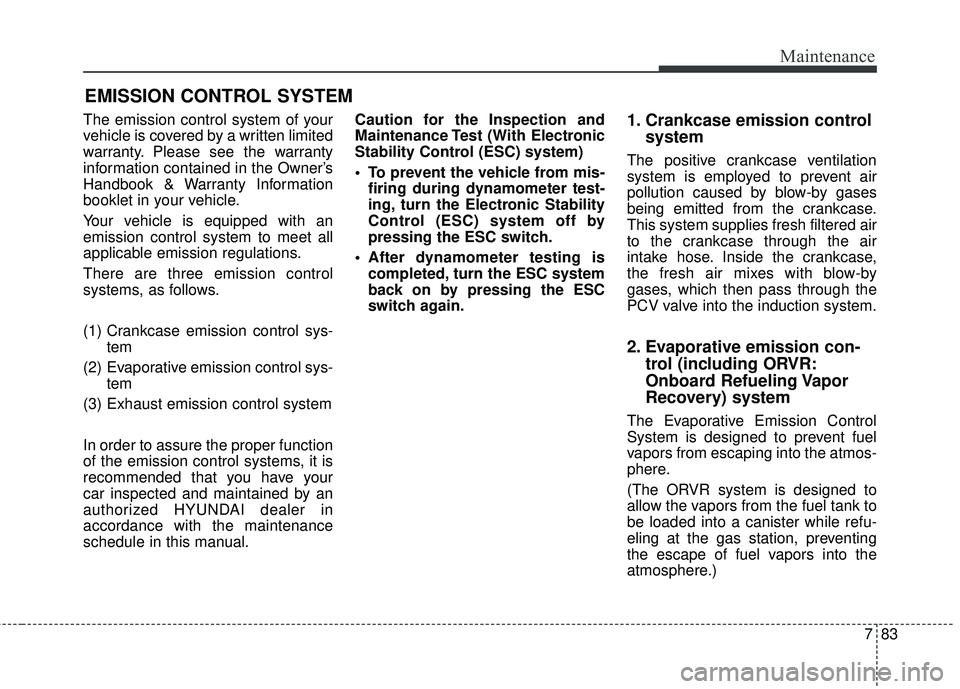
783
Maintenance
EMISSION CONTROL SYSTEM
The emission control system of your
vehicle is covered by a written limited
warranty. Please see the warranty
information contained in the Owner’s
Handbook & Warranty Information
booklet in your vehicle.
Your vehicle is equipped with an
emission control system to meet all
applicable emission regulations.
There are three emission control
systems, as follows.
(1) Crankcase emission control sys-tem
(2) Evaporative emission control sys- tem
(3) Exhaust emission control system
In order to assure the proper function
of the emission control systems, it is
recommended that you have your
car inspected and maintained by an
authorized HYUNDAI dealer in
accordance with the maintenance
schedule in this manual. Caution for the Inspection and
Maintenance Test (With Electronic
Stability Control (ESC) system)
To prevent the vehicle from mis-
firing during dynamometer test-
ing, turn the Electronic Stability
Control (ESC) system off by
pressing the ESC switch.
After dynamometer testing is completed, turn the ESC system
back on by pressing the ESC
switch again.1. Crankcase emission control system
The positive crankcase ventilation
system is employed to prevent air
pollution caused by blow-by gases
being emitted from the crankcase.
This system supplies fresh filtered air
to the crankcase through the air
intake hose. Inside the crankcase,
the fresh air mixes with blow-by
gases, which then pass through the
PCV valve into the induction system.
2. Evaporative emission con-trol (including ORVR:
Onboard Refueling Vapor
Recovery) system
The Evaporative Emission Control
System is designed to prevent fuel
vapors from escaping into the atmos-
phere.
(The ORVR system is designed to
allow the vapors from the fuel tank to
be loaded into a canister while refu-
eling at the gas station, preventing
the escape of fuel vapors into the
atmosphere.)
Page 459 of 475

Specifications, Consumer information, Reporting safety defects
48
RECOMMENDED LUBRICANTS AND CAPACITIES
These lubricants and fluids are recommended for use in your vehicle.
*1Refer to the recommended SAE viscosity numbers on the next page.
*2Engine oils labeled Energy Conserving Oil are now available. Along with other additional benefits, they contribute to fuel econo my by reducing
the amount of fuel necessary to overcome engine friction. Often, these improvements are difficult to measure in everyday driving, but in a year’s
time, they can offer significant cost and energy savings.
*
3If the API service SM engine oil is not available in your country, you are able to use API service SL, ILSAC GF-4, ACEA 3.
To help achieve proper engine and powertrain performance and durability, use only lubricants of the proper quality.
The correct lubricants also help promote engine efficiency that results in improved fuel economy.
LubricantVolumeClassification
Engine oil *1*2
(drain and refill)
Recommends6.02 US qt. (5.7 l)API service SM, ILSAC GF-4, ACEA A5 or above*3
Automatic transmission fluid10.14 US qt. (9.6 l)
GS ATF SP-IV-RR, HYUNDAI genuine
ATF SP-IV-RR or other brands meeting the above specification approved by HYUNDAI Motor Co.,
Manual transmission fluid2.3 ~ 2.4 US qt.
(2.2 ~ 2.3 l)
HK MTF 70W (SK)
SPIRAX S6 GHME 70W (H.K.SHELL) GS MTF HD 70W (GS CALTEX) API GL-4, SAE 70W
Use the Manual transaxle fluid approved by HYUNDAI motor com- pany. Consult an authorized HYUNDAI dealer for details.
Power steering0.95 US qt. (0.9 l)Pentosin CHF 202
CoolantM/T9.51 US qt. (9 l) Mixture of antifreeze and water
(Ethylene glycol base coolant for aluminum radiator)
A/T9.30 US qt. (8.8 l)
Brake fluid0.7 ~ 0.8 US qt. (0.7 ~ 0.8 l )SAE J1703, FMVSS116 DOT-3 or DOT-4
Fuel17.17 US gal. (65 l)Unleaded gasoline
Rear differential oil1.48 US qt. (1.4 l)Hypoid gear oil API GL-5, SAE 75W/90